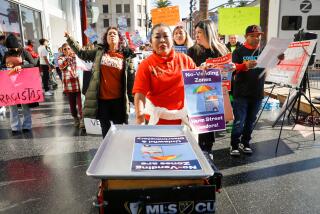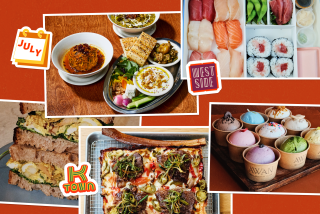A Healthy Trend Catches On : As farmers markets grow, fresh food movement may return to its roots
When California opened the way for its modern farmers-market movement with legislation in the 1970s, the urban markets, in addition to giving farmers a place to sell goods, were looked on as a place where low-income city residents could buy inexpensive produce.
Along came the ‘80s, and outdoor markets captured the loyalty of the hip and the well-heeled. Until a few days ago, the last three to open in Southern California were aimed at shoppers in Beverly Hills, Westwood and Encino.
So the April 1 opening of the Van Nuys farmers market, the sixth in the Valley area, represents a bit of a countertrend, a welcome return to the movement’s original intent.
It’s a true Van Nuys market, with greenhouse tomatoes trucked from afar and bok choy for Latino and Asian shoppers. Look elsewhere for itty-bitty veggies.
Grocery diversity is rampant at greater L.A.’s 33 farmers markets. Calabasas has cafe latte, book sales, a professional storyteller and eggless, sugarless, milkless, fatless bread. Burbank specializes in plain food at good, low prices.
It also speaks well of farmers markets that half of them--all those in the Valley--are run by and benefit nonprofit organizations (elsewhere, some are run by governments). The new Van Nuys market is run by the Volunteer Center of San Fernando Valley, for instance; Encino’s, by the Organization for the Needs of the Elderly.
The Valley could easily support two or three more markets, according to Mark Wall, coordinator for the Southland Farmers Market Assn. The Westside has eight or nine.
All that’s needed to start one, Wall says, is a stable nonprofit group that yearns to serve and has modest profit demands. Spinach, anyone?
More to Read
Eat your way across L.A.
Get our weekly Tasting Notes newsletter for reviews, news and more.
You may occasionally receive promotional content from the Los Angeles Times.










